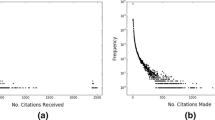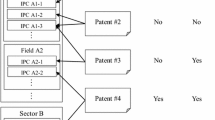Abstract
Technological trajectory is an attractive concept, but is hard to be operationalized. Challenging this issue, we suggest an extended technological trajectory method. It identifies not only the single main path, but derivative paths emanating from technology junctures on the main path. Convergence and divergence of technologies occur on junctures that are identified by using three indicators of technology generality, path-specific generality and path-specific novelty. Dynamic technology tree allows researchers to identify product component—patent linkages in a structured way, deepening our understanding about effects of technological developments on a product. In practice, our approach can help researchers better identify technologically related opportunities, thereby triggering the process from well-focused technology portfolio to technological advantages. High voltage direct current transmission technology is exemplified.



Similar content being viewed by others
References
Allebrod, S., Hamerski, R., & Marquardt, R. (2008). New transformerless, scalable modular multilevel converters for HVDC-transmission. In Power Electronics Specialists Conference, 2008 (pp. 174–179). IEEE.
Bahrman, M. P., & Johnson, B. K. (2007). The ABCs of HVDC transmission technologies. IEEE Power and Energy Magazine, 5, 32–44.
Barberá-Tomás, D., Jiménez-Sáez, F., & Castelló-Molina, I. (2011). Mapping the importance of the real world: The validity of connectivity analysis of patent citations networks. Research Policy, 40(3), 473–486.
Batagelj, V., & Mrvar, A. (2004). Pajek—Analysis and visualization of large networks. Berlin: Springer.
Calero-Medina, C., & Noyons, E. C. (2008). Combining mapping and citation network analysis for a better understanding of the scientific development: The case of the absorptive capacity field. Journal of Informetrics, 2(4), 272–279.
Callon, M., Courtial, J. P., Turner, W. A., & Bauin, S. (1983). From translations to problematic networks: An introduction to co-word analysis. Information, 22(2), 191–235.
Castaldi, C., Fontana, R., & Nuvolari, A. (2009). Chariots of fire: The evolution of tank technology. 1915–1945. Journal of Evolutionary Economics., 19(4), 545–566.
Chen, S., Huang, M., & Chen, D. (2012). Identifying and visualizing technology evolution: A case study of smart grid technology. Technological Forecasting and Social Change, 79(6), 1099–1110.
Chen, D., Huang, M., Hsieh, H., & Lin, C. (2011). Identifying missing relevant patent citation links by using bibliographic coupling in LED illuminating technology. Journal of Informetrics, 5(3), 400–412.
Chen, C., Paul, R. J., & O’Keefe, B. (2001). Fitting the jigsaw of citation: Information visualization in domain analysis. Journal of the Association for Information Science and Technology., 52(4), 315–330.
Choe, H., Lee, D. H., Seo, I. W., & Kim, H. D. (2013). Patent citation network analysis for the domain of organic photovoltaic cells: Country, institution, and technology field. Renewable and Sustainable Energy Review, 26, 492–505.
Choi, S., Park, H., Kang, D., Lee, J. Y., & Kim, K. (2012). An SAO-based text mining approach to building a technology tree for technology planning. Expert Systems with Applications, 39(13), 11443–11455.
Chuang, T. C., Liu, J. S., Lu, L. Y., & Lee, Y. (2014). The main paths of medical tourism: From transplantation to beautification. Tourism Management, 45, 49–58.
Davidson, C. C., & Trainer, D. R. (2010). Innovative concepts for hybrid multi-level converters for HVDC power transmission. In ACDC 9th IET International Conference on AC and DC Power Transmission, 2010 (pp. 1–5). IET.
Dosi, G. (1982). Technological paradigms and technological trajectories: A suggested interpretation of the determinants and directions of technical change. Research Policy, 11(3), 147–162.
Durand, T. (1992). Dual technological trees: Assessing the intensity and strategic significance of technological change. Research Policy, 21(4), 361–380.
Fontana, R., Nuvolari, A., & Verspagen, B. (2009). Mapping technological trajectories as patent citation networks. An application to data communication standards. Economics of Innovation and New Technology, 18(4), 311–336.
Frenken, K., & Leydesdorff, L. (2000). Scaling trajectories in civil aircraft (1913–1997). Research Policy, 29(3), 331–348.
Frenken, K., & Nuvolari, A. (2004). The early development of the steam engine: An evolutionary interpretation using complexity theory. Industrial and Corporate Change, 13(2), 419–450.
Frenken, K., Saviotti, P. P., & Trommetter, V. (1999). Variety and niche creation in aircraft, helicopters, motorcycles and microcomputers. Resesarch Policy, 28(5), 469–488.
Furukawa, T., Mori, K., Arino, K., Hayashi, K., & Shirakawa, N. (2015). Identifying the evolutionary process of emerging technologies: A chronological network analysis of World Wide Web conference sessions. Technological Forecasting and Social Change, 91, 280–294.
Garfield, E., Sher, I. H., & Torpie, R. J. (1964). The use of citation data in writing the history of science. Philadelphia: Institute for Scientific Information INC.
Griliches, Z. (1990). Patent statistics as economic indicators: A survey. National Bureau Of Economic Research. No. w3301. https://doi.org/10.3386/w3301.
Hall, B. H., & Trajtenberg, M. (2004). Uncovering GPTs with patent data. National Bureau Of Economic Research. No. w10901. https://doi.org/10.3386/w10901.
Harris, J. K., Luke, D. A., Zuckerman, R. B., & Shelton, S. C. (2009). Forty years of secondhand smoke research: The gap between discovery and delivery. American Journal of Preventive Medicine, 36(6), 538–548.
Heiss, M., & Jankowsky, J. (2001). The technology tree concept-an evolutionary approach to technology management in a rapidly changing market. In IEMC 2001 Proceedings of Change Management and the New Industrial Revolution, 2001 (pp. 37–43). IEMC.
Ho, J. C., Saw, E., Lu, L. Y. Y., & Liu, J. S. (2014). Technological barriers and research trends in fuel cell technologies: A citation network analysis. Technological Forecasting and Social Change, 82, 66–79.
Huang, M. H., Chen, S. H., Lin, C. Y., & Chen, D. Z. (2014). Exploring temporal relationships between scientific and technical fronts: A case of biotechnology field. Scientometrics, 98(2), 1085–1100.
Huang, Z., Chen, H., Yip, A., Ng, G., Guo, F., Chen, Z. K., et al. (2003). Longitudinal patent analysis for nanoscale science and engineering: Country, institution and technology field. Journal of Nanoparticle Research, 5(3–4), 333–363.
Hummon, N. P., & Carley, K. (1993). Social networks as normal science. Social Networks, 15(1), 71–106.
Hummon, N. P., & Doreian, P. (1989). Connectivity in a citation network: The development of DNA theory. Social Network, 11(1), 39–63.
Hummon, N. P., Doreian, P., & Freeman, L. C. (1990). Analyzing the structure of the centrality–productivity literature created between 1948 and 1979. Science Communication, 11(4), 459–480.
Hung, S. C., Liu, J. S., Lu, L. Y., & Tseng, Y. (2014). Technological change in lithium iron phosphate battery: The key-route main path analysis. Scientometrics, 100(1), 97–120.
Jaffe, A. B., & Trajtenberg, M. (2002). Patents, citations, and innovations: A window on the knowledge economy. Cambridge: MIT press.
Kirkels, A. F. (2014). Punctuated continuity: The technological trajectory of advanced biomass gasifiers. Energy Policy, 68, 170–182.
Kropsu-Vehkapera, H., Haapasalo, H., & Rusanen, J. P. (2009). Analysis of technology management functions in Finnish high tech companies. The Open Management Journal, 2, 1–10.
Kuhn, T. S. (1962). The structure of scientific revolutions. Chicago: Chicago University Press.
Lacasa, I., Grupp, H., & Schmoch, U. (2003). Tracing technological change over long periods in Germany in chemicals using patent statistics. Scientometrics, 57(2), 175–195.
Lee, P., Su, H., & Wu, F. (2010). Quantitative mapping of patented technology—The case of electrical conducting polymer nanocomposite. Technological Forecasting and Social Change, 77(3), 466–478.
Li, X., Chen, H., Huang, Z., & Roco, M. C. (2007). Patent citation network in nanotechnology (1976–2004). Journal of Nanoparticle Research, 9(3), 337–352.
Lin, Y., Chen, J., & Chen, Y. (2011). Backbone of technology evolution in the modern era automobile industry: An analysis by the patents citation network. Journal of Systems Science and Systems Engineering, 20(4), 416–442.
Liu, J. S., & Lu, L. Y. (2012). An integrated approach for main path analysis: Development of the hirsch index as an example. Journal of the American Society for Information Science and Technology, 63(3), 528–542.
Lucio-Arias, D., & Leydesdorff, L. (2008). Main-path analysis and path-dependent transitions in HistCite™-based historiograms. Journal of the American Society for Information Science and Technology, 59(12), 1948–1962.
Martinelli, A. (2012). An emerging paradigm or just another trajectory? Understanding the nature of technological changes using engineering heuristics in the telecommunications switching industry. Research Policy, 41(2), 414–429.
Mina, A., Ramlogan, R., Tampubolon, G., & Metcalfe, J. S. (2007). Mapping evolutionary trajectories: Applications to the growth and transformation of medical knowledge. Research Policy, 36(5), 789–806.
Mokyr, J. (2002). The gifts of athena: Historical origins of the knowledge economy. Princeton: Princeton University Press.
Moore, S., Haines, V., Hawe, P., & Shiell, A. (2006). Lost in translation: A genealogy of the “social capital” concept in public health. Journal of Epidemiology and Community Health, 60(8), 729–734.
Morris, S., Yen, G., Wu, Z., & Asnake, B. (2003). Time line visualization of research fronts. Journal of the Association for Information Science and Technology, 54(5), 413–422.
Nelson, R. R., & Winter, S. G. (1977). In search of useful theory of innovation. Research Policy, 6(1), 36–76.
Newman, M. E. J., & Girvan, M. (2004). Finding and evaluating community structure in networks. Physical Review E, 69(2), 026113.
Parayil, G. (2003). Mapping technological trajectories of the Green revolution and the Gene revolution from modernization to globalization. Research Policy, 32(6), 971–990.
Possas, M. L., Salles-Filho, S., & da Silveira, J. (1996). An evolutionary approach to technological innovation in agriculture: Some preliminary remarks. Research Policy, 25(6), 933–945.
Robinson, D. K., Huang, L., Guo, Y., & Porter, A. L. (2013). Forecasting innovation pathways for new and emerging science and technologies. Technological Forecasting and Social Change, 80(2), 267–285.
Saviotti, P. P., & Metcalfe, J. S. (1984). A theoretical approach to the construction of technological output indicators. Research Policy, 13(3), 141–151.
Schaller, R. R. (1997). Moore’s law: Past, present and future. IEEE Spectrum, 34(6), 52–59.
Small, H. (2006). Tracking and predicting growth areas in science. Scientometrics, 68(3), 595–610.
Small, H., & Griffith, B. (1974). The structure of scientific literatures: Identifying and graphing specialties. Science Studies, 4(1), 17–40.
Small, H., & Upham, P. (2009). Citation structure of an emerging research area on the verge of application. Scientometrics, 79(2), 365–375.
Verspagen, B. (2007). Mapping technological trajectories as patent citation networks: A study on the history of fuel cell research. Advances in Complex Systems, 10(1), 93–115.
Vincenti, W. G. (1994). The retractable airplane landing gear and the Northrop “anomaly”: Variation–Selection and the shaping of technology. Technology and Culture, 35(1), 1–33.
Von Wartburg, I., Teichert, T., & Rost, K. (2005). Inventive progress measured by multi-stage patent citation analysis. Research Policy, 34(10), 1591–1607.
Watanabe, C., Tsuji, Y. S., & Griffy-Brown, C. (2001). Patent statistics: Deciphering a ‘real’ versus a ‘pseudo’ proxy of innovation. Technovation, 21(12), 783–790.
White, H. D., & Griffith, B. C. (1981). Author cocitation: A literature measure of intellectual structure. Journal of the Association for Information Science and Technology, 32(3), 163–171.
Xiao, Y., Lu, L. Y., Liu, J. S., & Zhou, Z. (2014). Knowledge diffusion path analysis of data quality literature: A main path analysis. Journal of Informetrics, 8(3), 594–605.
Yuan, F., & Miyazaki, (2014). Understanding the dynamic nature of technological change using trajectory identification based on patent citation network in the electric vehicles industry. Proceedings of PICMET, 2014, 2780–2790.
Zhou, X., Zhang, Y., Porter, A. L., Guo, Y., & Zhu, D. (2014). A patent analysis method to trace technology evolutionary pathways. Scientometrics, 100(3), 705–721.
Author information
Authors and Affiliations
Corresponding author
Rights and permissions
About this article
Cite this article
Kim, J., Shin, J. Mapping extended technological trajectories: integration of main path, derivative paths, and technology junctures. Scientometrics 116, 1439–1459 (2018). https://doi.org/10.1007/s11192-018-2834-3
Received:
Published:
Issue Date:
DOI: https://doi.org/10.1007/s11192-018-2834-3




